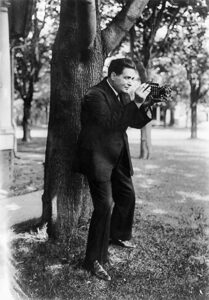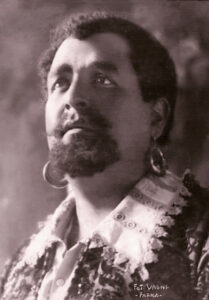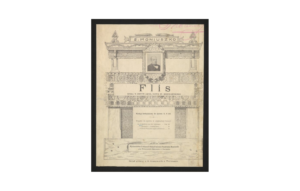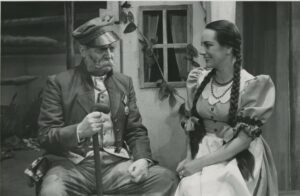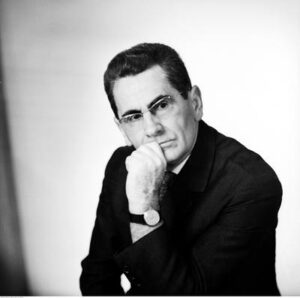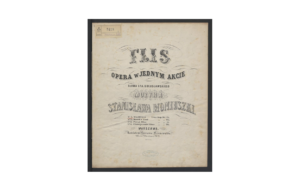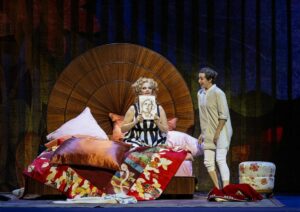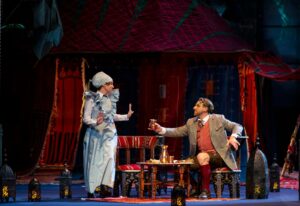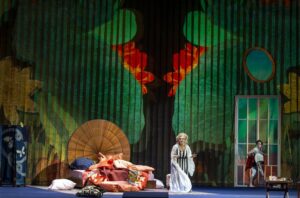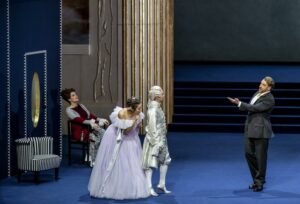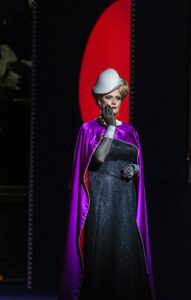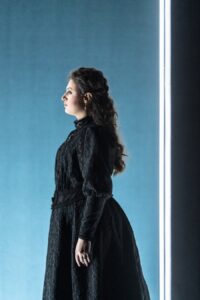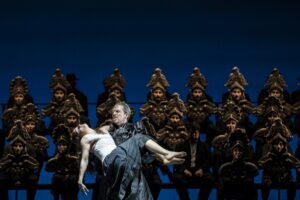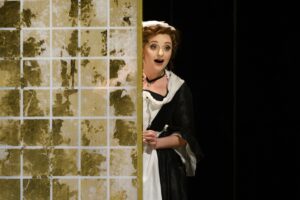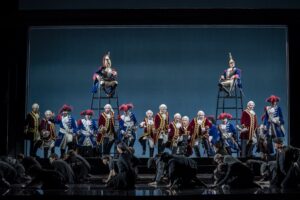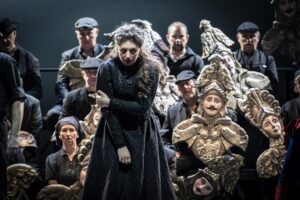Już nam wszytkim ludziom gorze
Życie muzyczne zamiera, teatry i filharmonie zawieszają działalność co najmniej do końca sezonu. Co to będzie? Jeszcze się zobaczy, ludzkość przeżyła już kilka podobnych katastrof – trzeba jednak pamiętać, że podnosiła się z nich długo i ruszała naprzód całkiem nową ścieżką. Dziś wiadomość dobra: właśnie ukazał się kolejny, tym razem podwójny numer „Ruchu Muzycznego”, a w nim – oprócz mnóstwa informacji i refleksji, jak sobie radzić w sytuacji obecnego kryzysu, także inne materiały, między innymi esej Anny Chęćki na marginesie Roku Ingardena oraz historia korespondencji Romana Palestra z PWM. Prenumeratorom pozostaje cierpliwie czekać na przesyłkę. Odcięci od świata mogą zamówić pismo online: https://pwm.com.pl/pl/sklep/serie/181/ruch-muzyczny. Kto naprawdę musi wyjść z domu, niech sprawdzi, czy w sąsiedztwie działa któryś z ostatnich wciąż jeszcze otwartych salonów Empiku: https://www.empik.com/pomoc/otwarte-salony. Poniżej mój tekst – o pierwszych reakcjach artystów, melomanów i światowych instytucji kultury na pandemię, która spadła na wszystkich jak grom z jasnego nieba.
***
Mam kolegę, który na co dzień zajmuje się analizą informatyczną – czyli, mówiąc po ludzku, tworzy analityczne modele rzeczywistości. Kolega, podobnie jak wielu fachowców pracujących w dziwnych dziedzinach, ma rozliczne pasje. Połączyła nas miłość do grzybów – poznaliśmy się w roku niespotykanego urodzaju na rydze, kiedy kolega zorganizował akcję sprzedaży tych delikatesów w osiedlowej kooperatywie spożywczej. Potem się okazało, że interesuje się nie tylko sztuką kulinarną, mykologią, wirusologią i epidemiologią, ale także muzyką. Przez kilka lat znajomości podzieliliśmy się mnóstwem fascynujących odkryć. Przekonałam się, że kolega jest naprawdę dobry w swoim zawodzie: przetwarza w rekordowym czasie ogromną liczbę danych i umiejętnie oddziela fakty od fakenewsów. W grudniu ubiegłego roku zwrócił uwagę na patogen, który wywołał pierwsze przypadki nowej choroby w Wuhanie.
Od tamtej pory kolega niestrudzenie szuka, modeluje i raportuje, dzieląc się plonem swojej aktywności z grupą przyjaciół. To dzięki niemu już przed miesiącem zaczęłam obserwować reakcje rządów, publicystów i świata muzycznego na tajemniczą zarazę, która powoli dezorganizuje świat, do jakiego pochopnie zdążyliśmy się przyzwyczaić. Właśnie dlatego z wyprzedzeniem odwoływałam wyjazdy w miejsca, gdzie wirus – zgodnie z informatycznym proroctwem – miał dotrzeć na kilka dni przed planowaną od dawna premierą lub koncertem. Jak do tej pory, żadna z tych kalkulacji nie zawiodła. Czy jesteśmy przygotowani na nieuchronną zmianę myślenia, odczuwania, a przede wszystkim działania w tej bezprecedensowej sytuacji, która coraz bardziej przypomina wojnę z niewidzialnym przeciwnikiem?
Częstą i wbrew pozorom bardzo naturalną reakcją obronną w stanach lękowych jest śmiech. Równie skutecznym sposobem na pokonanie stresu jest słuchanie muzyki, a jeszcze lepiej – aktywne muzykowanie. Znamienne, że jeden z najzabawniejszych krążących po internecie filmików związanych z obecnym kryzysem zdrowotnym powstał w Iranie – kraju, który pod względem liczby ofiar śmiertelnych COVID-19 ustępuje jedynie Włochom, i to według danych oficjalnych, zapewne mocno zaniżonych. Krótka instrukcja prawidłowego mycia rąk, przełożona na gesty dyrygenta prowadzącego orkiestrę w I Tańcu węgierskim Brahmsa, jest dziełem irańskiego aktora Daniala Kheirikhana. Pojawiła się w mediach społecznościowych pod koniec lutego, obiegła świat i doczekała się kliku naśladownictw, między innymi – a jakże! – przez muzyków włoskich. Ciekawe, ilu odbiorców tylko obśmiało strachy, ilu zaś odebrało ukryte w tym skeczu przesłanie edukacyjne, zwłaszcza że film krąży w wielu miejscach sieci pod hasztagiem #coronapanic. W miarę postępów pandemii kreatywność komików spada, wzrasta za to tendencja do wynajdywania perełek z przeszłości – choćby zabójczo śmiesznej piosenki Toma Lehrera I got it from Agnes z 1952 roku, w której autor przedstawia wzorcowy model rozprzestrzeniania się chorób zakaźnych. Nic zresztą dziwnego, bo Lehrer jest nie tylko wybitnym satyrykiem i muzykiem, lecz także specjalistą od statystyki matematycznej – i podobnie jak mój kolega, harmonijnie łączy wszystkie pasje: na Uniwersytecie Kalifornijskim wykładał kiedyś przedmiot pod roboczym tytułem Matma dla tenorów.
Tam, gdzie śmiech więźnie w gardle, rodzi się pierwotna potrzeba wykrzyczenia emocji. W najbardziej muzykalnych i dotkniętych największą tragedią krajach (znów Włochy) także pod postacią śpiewu. Pierwszy i jak dotąd najdobitniejszy film nagrano w nocy, na wyludnionej uliczce Sieny, gdzie niewidoczni mieszkańcy do zdarcia gardeł wyśpiewują hymn miasta Canto della Verbena. Do tej króciutkiej migawki wkrótce dołączyły następne: z balkonowych sesji tradycyjnej tammurriaty w Kalabrii i Kampanii; z okiennych występów włoskich tenorów, wykonujących słynną arię Kalafa z Turandot z większym zaangażowaniem i z celniej postawionym wysokim h w kulminacji niż w przypadku niejednej gwiazdy światowych scen; z inicjatywy barytona Armanda Ariostiniego, który zaśpiewał „Va, pensiero” z balkonu swojego mieszkania, z dedykacją dla pensjonariuszy mediolańskiej Casa Verdi, domu spokojnej starości dla muzyków. Za ich przykładem próbowali pójść mieszkańcy innych europejskich miast. Z miernym jak dotąd skutkiem. Balkonowego tenora w Wiedniu uciszono obcesowym „Ruhe! So schen ist des net!” („Cisza! To wcale nie jest piękne!”), w Warszawie skończyło się na nieśmiałym podśpiewywaniu przebojów jazzowych i rockowych na Muranowie i Saskiej Kępie.
Sytuacja, jak to się mówi, jest dynamiczna. Trudno przewidzieć, o czym i jakim głosem będziemy śpiewać za kilka tygodni, a może i miesięcy. Kiedy nad europejskimi instytucjami zawisło widmo masowych odwołań spektakli, koncertów i festiwali, rozćwierkały się Twittery najwybitniejszych muzyków w branży. Część zareagowała spokojnie, nawołując kolegów do odpowiedzialności i godząc się z perspektywą utraty kolejnych kontraktów, inni wpadli w spiralę denializmu, nazywając pandemię zagrożeniem niewiele poważniejszym od pospolitej grypy i publikując porady godne mądrości Doktora Zięby. Najbardziej emocjonalnie reagują śpiewacy operowi, którzy zważywszy na mechanizm transmisji koronawirusa powinni szczególnie się martwić o zdrowie własne i swoich najbliższych: na scenie nie sposób utrzymać zalecanego dystansu, nie wspominając już o zwiększonym ryzyku przenoszeniu patogenów drogą kropelkową. W najgorszej sytuacji są „zwykli” muzycy orkiestrowi, których argumenty mają niewielką siłę przebicia w porównaniu z motywacją niektórych celebrytów – a przecież orkiestry pracują godzinami stłoczone na niewielkiej powierzchni (kilka dni temu cała Sinfonia Lahti, licząca 53 instrumentalistów, wylądowała na kwarantannie z powodu wykrycia koronawirusa u jednego z nich). Cieszą reakcje wielu polskich artystów, którzy podeszli do sprawy z powagą i przedsięwzięli już pewne środki, żeby złagodzić finansowe skutki tej niespodziewanej katastrofy (list otwarty do Ministra Kultury i Dziedzictwa Narodowego, zainicjowany przez Adriana Rzetelskiego, tancerza i wiceprzewodniczącego poznańskiego oddziału ZASP). Martwią – choć nie dziwią – rozpaczliwe protesty muzyków za granicą, w większości freelancerów, walczących do upadłego o utrzymanie wydarzeń w programach instytucji, które nie mają zamiaru wypłacać im gaż za odwołane koncerty i spektakle.
Melomani na razie się cieszą. Najsłynniejsze teatry i filharmonie próbują lać oliwę na wzburzone wody, wypełniając ciszę obietnicami transmisji z zamkniętych koncertów, między innymi Budapest Festival Orchestra, która proponuje cykl streamingów pod znamiennym tytułem Quarantine soirées (rozwiązanie wątpliwe, patrz wyżej), lub otwierając bezpłatny dostęp do swoich archiwów. Niektóre szczodrze, jak Filharmonia Berlińska, gdzie przynajmniej przez miesiąc będzie można skorzystać o dowolnej porze z ponad sześciuset zarejestrowanych występów jednej z najlepszych orkiestr na świecie. Inne z pewnymi zastrzeżeniami – co dotyczy między innymi Staatsoper w Wiedniu i nowojorskiej Metropolitan Opera, które proponują 24-godzinny dostęp do wybranych przez siebie spektakli. Do grona bezpłatnych „pocieszycieli” lawinowo dołączają kolejne prestiżowe teatry: Opera Paryska, berlińska Staatsoper, Teatro Massimo di Palermo. Sęk w tym, jak długo to potrwa, jak wpłynie na kondycję finansową instytucji, przede wszystkim zaś – czy nie zmieni nawyków odbiorców, którzy już wcześniej mieli skłonność do traktowania muzyków jak maszynki do grania i śpiewania. Nawet teraz protestują, kiedy dyrekcje instytucji kultury proszą ich o rozważenie, czy przeznaczyć przynajmniej część pieniędzy ze zwrotu niewykorzystanych biletów na wsparcie artystów wysłanych na przymusowe bezrobocie. Artystów, którzy nie tylko nie mogą wykonywać zawodu, ale często nie mają też okazji praktykowania niektórych elementów swojego warsztatu w ramach codziennych prób (kryzys znów najmocniej uderza w muzyków scenicznych).
Najbardziej kreatywni próbują rozwiązań pośrednich, z korzyścią dla poszkodowanych kolegów po fachu: jak Joyce DiDonato i Piotr Beczała, którzy zdecydowali się na transmisję fragmentów Wertera z mieszkania śpiewaczki, zachęcając odbiorców do przeznaczenia choćby najmniejszej kwoty na konto wybranych organizacji, teatrów i orkiestr. Muzycy La Scali próbują ćwiczyć w domach, łącząc się on-line z innymi członkami zespołu. Znów pozostaje pytanie, na jak długo starczy im zapału, funduszy i najzwyklejszej ludzkiej motywacji.
Sytuacja jest poważna i daleka od spójnych rozwiązań, nawet w obrębie niewielkiego kontynentu europejskiego. W większości krajów instytucje muzyczne stanęły w myśl odgórnej decyzji rządowej, co daje im – przynajmniej teoretycznie – nadzieję na wdrożenie systemowych środków zaradczych. Tak jest między innymi w Polsce, Włoszech, Francji, Hiszpanii i Austrii. W Niemczech decyzja o przerwaniu działalności teatrów i sal koncertowych leży w gestii władz poszczególnych landów. W pierwszej kolejności zareagował rząd bawarski, zamykając Bayerische Staatsoper do 19 kwietnia; tymczasem rząd Nadrenii-Północnej Westfalii, która wciąż jest epicentrum zakażeń na obszarze Niemiec, do tej pory nie może się zdecydować na zamknięcie instytucji kultury w mniejszych ośrodkach. Po zmianie strategii rządu Borisa Johnsona w walce z COVID-19 (poprzednia, oparta na koncepcji wytworzenia tzw. „odporności stadnej” spotkała się z gwałtownym sprzeciwem – jej wdrożenie oznaczałoby w praktyce nawrót do osławionych eksperymentów eugenicznych z lat 30.) instytucje zwijają manatki z własnej inicjatywy. Za „sugestią” premiera nie poszły żadne rozwiązania prawne ani obietnice gwarancji finansowych. Mimo to decyzję podjęły już Royal Opera House, Wigmore House i English National Opera, odwołano letni festiwal Grange Park Opera, ważą się losy Glyndebourne. Mało kto zdaje sobie sprawę, że przy obecnym stanowisku rządu brytyjskiego ten Feniks może już nigdy nie powstać z popiołów.
Kolega wciąż tworzy swoje modele rzeczywistości dotkniętej plagą SARS-CoV-2. Rzeczywistość zmienia się z dnia na dzień, ale jedno da się już uznać za pewnik. Życie muzyczne nie wróci w dawnej postaci. I to wbrew pozorom może być dobra wiadomość. Przeżyliśmy kilka takich końców świata, między innymi zamachy na WTC w 2001 roku. Tak dawno temu, że zapomnieliśmy, jak było przedtem. Jeśli uda się zdusić tę zarazę, liczę na to, że świat muzyczny odrodzi się mądrzejszy: pełen empatii i szacunku wobec innych artystów, wolny od pychy, blichtru i taniego poklasku. W naszym końcu nasz początek.




